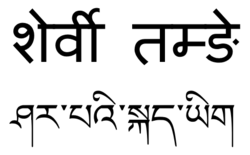Linguistics is the scientific study of human language. Someone who engages in this study is called a linguist. See also the Outline of linguistics, the List of phonetics topics, the List of linguists, and the List of cognitive science topics. Articles related to linguistics include:
Case roles, according to the work by Charles Fillmore (1967), are the semantic roles of noun phrases in relation to the syntactic structures that contain these noun phrases. The term case role is most widely used for purely semantic relations, including theta roles and thematic roles, that can be independent of the morpho-syntax. The concept of case roles is related to the larger notion of Case which is defined as a system of marking dependent nouns for the type of semantic or syntactic relationship they bear to their heads. Case traditionally refers to inflectional marking.

The Tibetic languages form a well-defined group of languages descended from Old Tibetan. According to Tournadre (2014), there are 50 languages, which split into over 200 dialects or could be grouped into 8 dialect continua. These languages are spoken in the Tibetan Plateau and in the Himalayas in Gilgit-Baltistan, Aksai Chin, Ladakh, Nepal, Himachal Pradesh, Uttarakhand, Bhutan, and the Kachin State of Myanmar. Classical Tibetan is the major literary language, particularly for its use in Buddhist literature.
In linguistics, a determiner phrase (DP) is a type of phrase headed by a determiner such as many. Controversially, many approaches, take a phrase like not very many apples to be a DP, headed, in this case, by the determiner many. This is called the DP analysis or the DP hypothesis. Others reject this analysis in favor of the more traditional NP analysis where apples would be the head of the phrase in which the DP not very many is merely a dependent. Thus, there are competing analyses concerning heads and dependents in nominal groups. The DP analysis developed in the late 1970s and early 1980s, and it is the majority view in generative grammar today.
Warrongo is an Australian Aboriginal language, one of the dozen languages of the Maric branch of the Pama–Nyungan family. It was formerly spoken by the Warrongo people in the area around Townsville, Queensland, Australia. Its last native speaker was Alf Palmer, who died in 1981.

Crow is a Missouri Valley Siouan language spoken primarily by the Crow Nation in present-day southeastern Montana. The word, Apsáalooke, translates to "children of the raven." It is one of the larger populations of American Indian languages with 2,480 speakers according to the 1990 US Census.
Sidama or Sidaamu Afoo is an Afro-Asiatic language belonging to the Highland East Cushitic branch of the Cushitic family. It is spoken in parts of southern Ethiopia by the Sidama people, particularly in the densely populated Sidama National Regional State (SNRS). Sidaamu Afoo is the ethnic autonym for the language, while Sidaminya is its name in Amharic. It is not known to have any specific dialects. The word order is typically SOV. Sidaama has over 100,000 L2 speakers. The literacy rate for L1 speakers is 1%-5%, while for L2 speakers it is 20%. In terms of its writing, Sidaama used an Ethiopic script up until 1993, from which point forward it has used a Latin script.

Gurung, also known as Tamu Kyi or Tamu Bhāṣā, is a Sino-Tibetan language spoken by the Gurung people of Nepal. The total number of all Gurung speakers in Nepal was 227,918 in 1991 and 325,622 in 2011.

Lepcha language, or Róng language, is a Himalayish language spoken by the Lepcha people in Sikkim, India and parts of West Bengal, Nepal, and Bhutan.
The Sikkimese language, also called Sikkimese, Bhutia, or Drenjongké, Dranjoke, Denjongka, Denzongpeke and Denzongke, belongs to the Tibeto-Burman languages. It is spoken by the Bhutia in Sikkim, India and in parts of Koshi, Nepal. It is the Official Language of Sikkim, India. The Sikkimese people refer to their own language as Drendzongké and their homeland as Drendzong. Up until 1975 Sikkimese was not a written language. After gaining Indian Statehood the language was introduced as a school subject in Sikkim and the written language was developed.
Nunation, in some Semitic languages such as Literary Arabic, is the addition of one of three vowel diacritics (ḥarakāt) to a noun or adjective.
Classical Tibetan refers to the language of any text written in Tibetic after the Old Tibetan period. Though it extends from the 12th century until the modern day, it particularly refers to the language of early canonical texts translated from other languages, especially Sanskrit. The phonology implied by Classical Tibetan orthography is very similar to the phonology of Old Tibetan, but the grammar varies greatly depending on period and geographic origin of the author. Such variation is an under-researched topic.

Lhasa Tibetan, or Standard Tibetan, is the Tibetan dialect spoken by educated people of Lhasa, the capital of the Tibetan Autonomous Region. It is an official language of the Tibet Autonomous Region.

The Tarahumara language is a Mexican Indigenous language of the Uto-Aztecan language family spoken by around 70,000 Tarahumara (Rarámuri/Ralámuli) people in the state of Chihuahua, according to a 2002 census conducted by the government of Mexico.
Nivaclé is a Matacoan language spoken in Paraguay and in Argentina by the Nivaclé. It is also known as Chulupí and Ashluslay, and in older sources has been called Ashluslé, Suhin, Sujín, Chunupí, Churupí, Choropí, and other variant spellings of these names. Nivaclé speakers are found in the Chaco, in Paraguay in Presidente Hayes Department, and Boquerón Department, and in Argentina in Salta Province.

Aguaruna is an indigenous American language of the Chicham family spoken by the Aguaruna people in Northern Peru. According to Ethnologue, based on the 2007 Census, 53,400 people out of the 55,700 ethnic group speak Aguaruna, making up almost the entire population. It is used vigorously in all domains of life, both written and oral. It is written with the Latin script. The literacy rate in Aguaruna is 60-90%. However, there are few monolingual speakers today; nearly all speakers also speak Spanish. The school system begins with Aguaruna, and as the students progress, Spanish is gradually added. There is a positive outlook and connotation in regard to bilingualism. 50 to 75% of the Aguaruna population are literate in Spanish. A modest dictionary of the language has been published.
Tibetan grammar describes the morphology, syntax and other grammatical features of Lhasa Tibetan, a Sino-Tibetan language. Lhasa Tibetan is typologically an ergative–absolutive language. Nouns are generally unmarked for grammatical number, but are marked for case. Adjectives are never marked and appear after the noun. Demonstratives also come after the noun but these are marked for number. Verbs are possibly the most complicated part of Tibetan grammar in terms of morphology. The dialect described here is the colloquial language of Central Tibet, especially Lhasa and the surrounding area, but the spelling used reflects classical Tibetan, not the colloquial pronunciation.
Nabak is a Papuan language spoken by around 16,000 people in the Morobe Province located in the western Huon Peninsula of Papua New Guinea. Nabak follows the SOV typology. It uses Latin script in its written form.
Manang, also called Manangba, Manange, Manang Ke, Nyishang, Nyishangte and Nyishangba, is a Sino-Tibetan language spoken in Nepal. Native speakers refer to the language as ŋyeshaŋ, meaning 'our language'. Manang and its most closely related languages are often written as TGTM in literature, referring to Tamang, Gurung, Thakali, and Manangba, due to the high degree of similarity in the linguistic characteristics of the languages. The language is unwritten and almost solely spoken within the Manang District, leading it to be classified as threatened, with the number of speakers continuing to decline. Suspected reasons for the decline include parents not passing down the language to their children, in order to allow for what they see as more advanced communication with other groups of people, and thus gain more opportunities. Due to the proximity of the district to Tibet, as well as various globally widespread languages being introduced into the area, use of the native language is declining in favor of new languages, which are perceived to aid in the advancement of the people and region.

The indigenous languages of the Americas form various linguistic areas or Sprachbunds that share various common (areal) traits.










